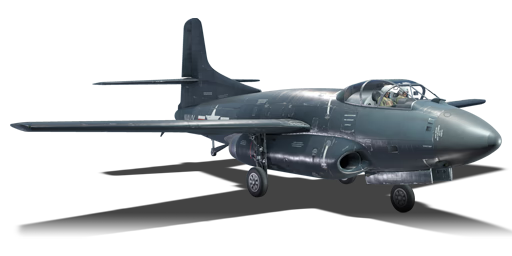



During 1945, the Navy was discussing the idea of a jet-powered aircraft that could operate from carriers. In addition, it was required to have radar and fly in night conditions. Out of 4 companies, Douglas' proposal would ultimately earn the Navy's full attention and they were awarded contracts to build 3 prototypes. Soon after, the name Skyknight was chosen for the project. In 1948, the XF3D-1 was ready for its first flight. It was to be powered by two J34-WE-22 engines and a preliminary radar as the APQ-65 was unavailable at the time. Two XF3D-1's were built with the SCR-720 radar until the third prototype which received the planned APQ-65. After test flights showed the Skyknight to be a capable aircraft, 28 F3D-1s were ordered for both the USMC and USN. The production F3D-1 received a few changes such as better engines (J-34-WE-34) and gained around 5,000 lbs (2,267 kg) in weight.
Introduced in Update 1.75 "La Résistance", the F3D-1 is a very capable aircraft that can fit many roles. In air-to-air combat, the F3D-1 can hold its own with its good turn rate and four M3 cannons mounted in the nose. In addition, the Skyknight receives an attacker airspawn which greatly helps its capability. The Skyknight can also be effectively used against ground targets due to its high-powered cannons, bombs, and Tiny Tim rockets. The cannons have plentiful ammo and have 16 seconds of trigger time. Players can confidently use the F3D-1 Skyknight against air and ground targets.
flaps
flaps
flaps
brake
| Belt | Belt filling | Armor penetration (mm) at a distance: | |||||
|---|---|---|---|---|---|---|---|
| 10 m | 100 m | 500 m | 1000 m | 1500 m | 2000 m | ||
| HEF-I/AP-T | 36 | 33 | 23 | 15 | 9 | 6 | |
| AP-T/AP-T/HEF-I/HEF-I | 36 | 33 | 23 | 15 | 9 | 6 | |
| HEF-I/HEF-I/HEF-I/AP-T | 36 | 33 | 23 | 15 | 9 | 6 | |
| AP-T/AP-T/AP-T/HEF-I | 36 | 33 | 23 | 15 | 9 | 6 | |
| HEF-I | 5 | 4 | 3 | 2 | 2 | 2 | |












Flight performance | |
|---|---|
Survivability |
|---|
Weaponry | |
|---|---|